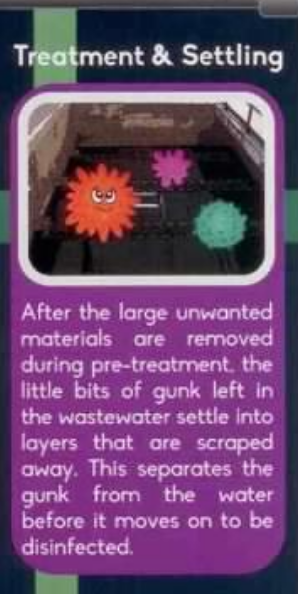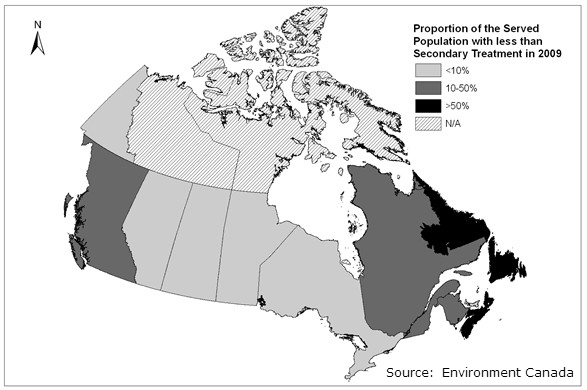Today, we’re going to talk about the Canadian federal government’s Wastewater System Effluent Regulations (WSER), soon to be a major motion picture starring Ryan Gosling and Rachel McAdams. (That’s not true but it gave you hope for a moment, didn’t it? You thought, “Great, I’ll just wait for the movie.” But no, you’re going to have to read this article.)

Source: CBRM
Introduced in 2012 under the Fisheries Act, the regulations apply to wastewater systems that deposit “a deleterious substance…in water.” In other words, to much of the wastewater the CBRM currently dumps into the Atlantic Ocean. Meeting the regulations will mean providing secondary wastewater treatment across the board. (Briefly, primary treatment involves “basic processes to remove suspended solid waste and reduce its biochemical oxygen demand” while secondary treatment “uses biological processes to catch the dissolved organic matter missed in primary treatment.” You can read more here.)
Operators of wastewater systems had until 30 June 2014 to apply for transitional authorizations, which Environment Canada described as “the conditions under which such a system may continue to operate with a risk-based timeline to meet the national effluent quality standards.”
The idea was to give operators time to draft a strategy — or more to the point, find funding for a strategy — to allow them to meet compliance deadlines. Those deadlines are staggered, depending on whether a wastewater system is considered high-risk (2020), medium-risk (2030) or low-risk (2040). (The risk levels are assigned based on a number of factors, but it’s basically what you’re dumping and how much of it you’re dumping.)
Dilution solution
Before focusing on the CBRM, I should point out that this problem is a coastal problem, although, as you can see from this map, one coast is in rather worse shape than the other:
Speaking to Whitney Matusiak in Water Canada in 2014, Tony Van Rossum of the Canadian Water and Wastewater Association said that “except for the East and West coasts, the regulation didn’t have much of an impact on municipalities in between, having had secondary treatment for a number of years.” (Van Rossum works for the city of London, Ontario which has had secondary treatment since 1980).
We in the coastal communities have been relying on dilution rather than secondary treatment for hundreds of years, but as of 2020, that’s supposed to change.
Price tag
So how does this affect the CBRM?

Source: CBRM
Spokesperson Jillian Moore told me that the people I need to speak to are on vacation this week but promised me answers for next week’s edition. In the meantime, I will quote the CBRM’s then-wastewater operations manager, Ron Delaney, who didn’t pull any punches speaking to Water Canada in 2014:
“Not a whole lot of thought was put into what the cost in some areas would be to get up to these standards,” said Ron Delaney, CBRM’s manager of wastewater operations. CBRM has more than 50 raw sewer outfalls needing centralized treatment facilities, which in turn require upstream collection pipes, pumping stations, and the technology to achieve WSER’s effluent equality standards. In CBRM, it’s not just about plant compliance, but about the wastewater network as a whole, and it’s not clear if Environment Canada’s funding accounts for works of that scale.
“The west coast is facing the same problem,” Delaney said. “But they have lots of studies, lots of data. They’re more of a ‘have’ area, we’re more of a ‘have not’ area.”
Meanwhile, Delaney lamented that “right now [we have] no plan on paper to address all these outfalls.” He predicted that CBRM will need eight brand new WSER-compliant wastewater treatment plants at an estimated cost of $150 million—and the cost of collecting the wastewater will be almost twice that amount. The province is in dire financial straits, too, which limits access to certain federal funds that require matching contributions.
The price tag associated with the work has been estimated at an “astronomical” (Matusiak’s word) $454 million.
Temporary reprieve
In June 2014, the CBRM applied for and received transitional authorizations for the following wastewater systems:
| System Name | System City | Schedule 2 Points | Schedule 3 Points | Duration of Transitional Authorization |
|---|---|---|---|---|
| Battery Point Treatment | Sydney | 44 | Not used in application | From January 1, 2015 to December 31, 2040 |
| Donkin Sewer Shed -- D1 | Donkin | 38 | Not used in application | From January 1, 2015 to December 31, 2040 |
| Glace Bay -- GB1 | Glace Bay | 31 | Not used in application | From January 1, 2015 to December 31, 2040 |
| Glace Bay -- GB2 | Glace Bay | 37 | Not used in application | From January 1, 2015 to December 31, 2040 |
| Glace Bay -- GB4 | Glace Bay | 351 | Not used in application | From January 1, 2015 to December 31, 2020 |
| Glace Bay -- GB5 | Glace Bay | 43 | Not used in application | From January 1, 2015 to December 31, 2040 |
| Glace Bay -- GB6 | Sydney | 84 | Not used in application | From January 1, 2015 to December 31, 2020 |
| Glace Bay -- GB7 | Sydney | 34 | Not used in application | From January 1, 2015 to December 31, 2040 |
| Glace Bay -- GB8 | Glace Bay | 127 | Not used in application | From January 1, 2015 to December 31, 2020 |
| Louisbourg -- L1 | Louisbourg | 34 | Not used in application | From January 1, 2015 to December 31, 2040 |
| Louisbourg --- L2 | Louisbourg | 39 | Not used in application | From January 1, 2015 to December 31, 2040 |
| New Victoria Sewer Shed | New Victoria | 40 | Not used in application | From January 1, 2015 to December 31, 2040 |
| New Waterford -- NW1 | New Waterford | 44 | Not used in application | From January 1, 2015 to December 31, 2040 |
| New Waterford -- NW2 | New Waterford | 36 | Not used in application | From January 1, 2015 to December 31, 2040 |
| North Sydney, Sydney Mines, Florence (North Division -- ND2) | Sydney Mines | 49 | Not used in application | From January 1, 2015 to December 31, 2040 |
| Port Morien Sewer Shed | Port Morien | 89 | Not used in application | From January 1, 2015 to December 31, 2020 |
| Westmount/Coxheath -- C1 | Edwardsville | 56 | Not used in application | From January 1, 2015 to December 31, 2030 |
| Westmount/Coxheath -- C2 | Edwardsville | 30 | Not used in application | From January 1, 2015 to December 31, 2040 |
| Westmount/Coxheath -- C3 | Edwardsville | 64 | Not used in application | From January 1, 2015 to December 31, 2030 |
I’ve highlighted the four that expire in 2020 because they are, obviously, the ones of most immediate concern.
Progress…almost
In June 2015, the federal government announced with great fanfare (okay, as much fanfare as ever accompanies a sewage treatment announcement) $19 million in funding for upgrades to CBRM’s wastewater infrastructure, one-third of a total of $58 million, the rest to come from the province and the municipality. As the Post reported:
Source: CBRM
Justice Minister Peter MacKay announced on Tuesday that the federal government is contributing $19 million toward the 10-year undertaking that will involve the construction of a new wastewater collection system and treatment facility on the Westmount side of Sydney Harbour.
Matt Viva, CBRM’s manager of wastewater operations was cautiously enthusiastic — the project was a start, he said, but once it was complete “we will still have seven more to go, including Glace Bay, New Waterford and the Northside.”
Still it was a start…except that it actually wasn’t.
In March 2016, facing what he described as a $2.4 million budget shortfall, CBRM Mayor Cecil Clarke put the wastewater work on hold until, as the Post reported, the CBRM could:
…get some certainty from the province that it can afford the operational costs and repay the capital borrowing on an ongoing basis. In pressing the brakes on wastewater, Clarke said it was hoped the CBRM would be able to at least look after more pressing needs.
Consequences
We’re now three years away from the 2020 deadline for four of those wastewater systems, which might qualify as a “pressing” need.
I asked Environment Canada spokesperson Tamara Gates if the transitional authorizations could be extended. She replied by email:
There are no provisions in the Wastewater Systems Effluent Regulations to extend a transitional authorization.
I asked what sanctions the CBRM would face if it failed to meet the 2020 deadline and she said:
When Environment and Climate Change Canada enforcement officers become aware of an alleged violation of the WSER, or of the pollution prevention provisions of the Fisheries Act, they take appropriate action in accordance with the Compliance and Enforcement Policy for the Habitat Protection and Pollution Prevention Provisions of the Fisheries Act…
That Compliance and Enforcement Policy states:
The following responses are available to deal with alleged violations of the habitat protection and pollution prevention provisions of the Fisheries Act:
- warnings;
- directions by Fishery Inspectors;
- orders by the Minister;
- injunctions; and
- prosecutions.
2020
Stick with me here, I’m going to revisit an article I wrote last week but there’s a connection, I promise.

Source: CBRM
When Clarke went to the provincial Department of Municipal Affairs (DMA) in 2016 looking for economic development funding, the DMA offered the CBRM $225,000 of which $125,000 would be earmarked “for necessary studies to implement recommendations/solutions…for example, funding could be used to support a wastewater infrastructure study that would examine the cost of meeting the Canadian Council of Ministers of the Environment (CCME) wastewater effluent standards in CBRM.”
Now remember what Ron Delaney told Water Canada in 2014 about the West Coast’s advantage over the East Coast in meeting WSER standards: “they have lots of studies, lots of data.”
Now consider that three of the wastewater systems rated “high-risk” and in need of upgrade by 2020 bear the name “Glace Bay.”
Now consider that meeting the WSER regulations could have implications for the fishing and tourism industries — both of which matter to Glace Bay.
Might it have made more sense to fund a WSER-compliance study rather than drafting a Glace Bay “revitalization plan” with a 20-year timeline and no visible sources of funding, which is how the CBRM (read: Business Cape Breton) chose to use that money?
Positive Change No. 45
I hope to have a response from the CBRM for you next week. In the meantime, I thought I’d leave you with what Mayor Cecil Clarke had to say about wastewater in his 2016 election platform — the famous “100 More Positive Changes for CBRM.” Here’s Positive Change No. 45:
CBRM will re-commit to wastewater treatment projects pending a new funding formula arrangement with the federal and provincial governments.
Of course, the initial WSER deadlines are in December 2020 and our mayor — whose first pronouncement upon being re-elected in 2016 was that he was not going to run again — will be gone as of October that year.
Is it a case of getting out before the untreated effluent hits the fan?
[signoff]









